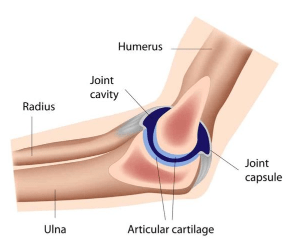Elbow pain
The elbow consists of two joints: the upper arm bone (humerus) and two bones in the forearm (ulna and radius). Each bone has cartilage on the end, which helps them slide against each other and absorb shocks. These joints are also surrounded by muscles and tendons which allow the elbow to move freely and comfortably. There are numerous nerves which pass close to the joint, including the ulna nerve, radial nerve, and median nerve.

Your elbow allows you to throw, lift, swing, and much more. If any injury or strain affects any parts of your elbow (including the nerves surrounding them) it can cause pain, pins and needles, and discomfort. There are many reasons for elbow pain, some of which are outlined below:
One-time injuries are hopefully one-off events. For example, you may fall and hit or knock your elbow hard
Dislocated elbow is when one of the bones that forms the elbow gets knocked out of place and causes you pain.
Fractured elbow is when your arm breaks at the elbow. This will normally happen with a sudden blow or contact sport and will need immediate medical attention.
Strains and sprains will happen if you push yourself a little too much and your muscles or ligaments get stretched or torn. You can get a strain when you put too much pressure on your elbow muscles, perhaps lifting heavy objects or even playing too much tennis.
How is elbow pain diagnosed?
A physiotherapist will discuss your medical history and ask a number of different questions to assist in their diagnosis:
- Where is the pain located?
- Do you have pins and needles down your arm?
- Can you bend your elbow?
- Is the pain dull or sharp?
- How intense is the pain?
- Are your fingers affected? Can you grip?
- Is your shoulder or neck affected?
- Is the pain constant or intermittent?
- What makes the pain worse and what makes it feel better?
- How does it affect your daily life?
- Can you lift anything?
- Can you play sport?
All these questions together with a physical examination will aid your therapist in diagnosing the elbow pain and determine a treatment plan for you. If the pain does not subside within a few weeks your physiotherapist may recommend you get an X-ray or MRI scan to assist with the diagnosis and treatment strategy.
Possible causes of elbow pain:
- Osteoarthritis
- Bursitis
- Ligamentous strain
- Muscular sprain
- Tennis elbow
- Golfers elbow
- Trapped nerves e.g. compression of the ulna nerve
- Fracture of your humerus, radius or ulna
- Dislocation of the head of the radius (usually in children)
- Osteochondritis dissecans
- Gout
- Rheumatoid arthritis
- Hypermobility syndrome
- Referral of symptoms from the neck, thoracic spine, shoulder, wrist or hand
- Cancer: rare
How to treat elbow pain
Suggestions for treatment include:
- Heat Therapy
- Ice Therapy
- Physiotherapy
- Pain medication
- Rest and activity modification
- Using an elbow strap to protect the joint
- Steroid injection
- Improving the desk/ chair position at the computer
How we can help your elbow pain
We will do whatever we can to get you on the fastest route to recovery. Some of the treatment methods we use include:
- Mobilisations
- Strengthening exercises
- Myofascial trigger point release
- Cross-friction massage
- Stretching and range of movement exercises
- Acupuncture
- Functional exercises
- Postural exercises
- Taping
